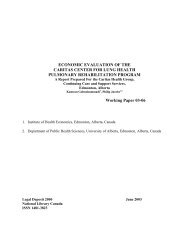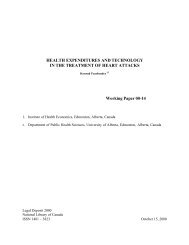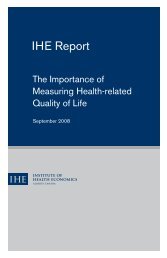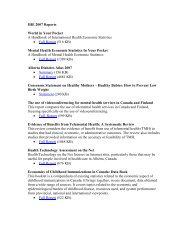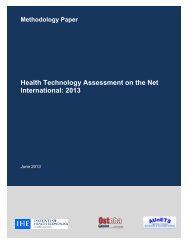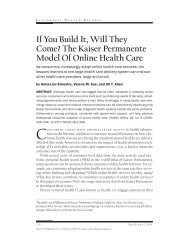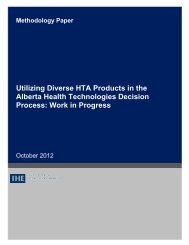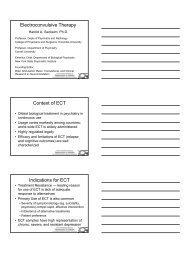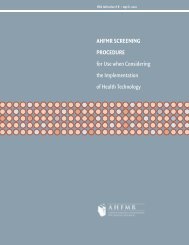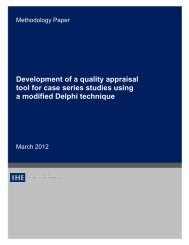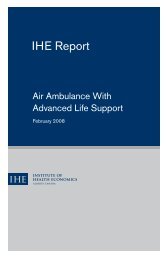Bariatric treatments for adult obesity - Institute of Health Economics
Bariatric treatments for adult obesity - Institute of Health Economics
Bariatric treatments for adult obesity - Institute of Health Economics
- No tags were found...
You also want an ePaper? Increase the reach of your titles
YUMPU automatically turns print PDFs into web optimized ePapers that Google loves.
Definition <strong>of</strong> bariatric surgical patientsTable E.1 outlines the CCI codes that correspond to a specific type <strong>of</strong> bariatric surgery. Patientswere included in the analysis if they had any one <strong>of</strong> these codes listed in the principal interventionfield in the DAD.Table E.1: CCI code description <strong>for</strong> bariatric surgeriesOpen approachLaparoscopicapproachDescription1.NF.78.XP 1.NF.78.EJ Using vertical banded technique1.NF.78.WJ 1.NF.78.GB Using vertical (sleeve) gastrectomy technique1.NF.78.SH 1.NF.78.DQ Using gastric bypass technique with gastroenterostomy (e.g., Roux-en-Y)1.NF.78.SJ1.NF.78.SI1.NF.78.DO1.NF.78.DIUsing gastric bypass technique with gastroenterostomy and biliopancreaticbypass [to terminal ileum] (e.g., biliopancreatic diversion)Using gastric bypass technique with enteroenterostomy and biliopancreaticbypass [to terminal ileum] (e.g., duodenal switch)Secondary analysis <strong>of</strong> Provincial <strong>Health</strong> Utilization databases and CCHS dataSource <strong>of</strong> in<strong>for</strong>mationIn<strong>for</strong>mation on health service utilization was retrieved from the three provincial health utilizationdatabases identified above. <strong>Health</strong> utilization data from 2007 was linked with epidemiologic (BMI),demographic (age, gender, income, and education), behavioural (smoking status and physicalactivity), and health status (presence <strong>of</strong> diabetes, hypertension, COPD, and back problems) datacontained in the 2007 CCHS.AnalysisSix separate multivariate regression models were developed to estimate the impact <strong>of</strong> BMI onphysician visits, physician costs, outpatient visits, outpatient costs, combined physician andoutpatient costs, and inpatient admissions. Note that inpatient costs were unavailable in the dataset.BMI was divided into four categories characterizing underweight, normal weight, overweight, andobese (as defined in the S section <strong>of</strong> this report). Furthermore, each model was adjusted <strong>for</strong> age,gender, income, education, smoking status, physical activity, and the presence <strong>of</strong> diabetes,hypertension, COPD, and back problems. All analyses were conducted with STATA 9.1 (StatacorpLP, College Station, Texas). Statistical significance was defined at p < 0.05.Calculation <strong>of</strong> health service utilization and costsAdjusted estimates <strong>of</strong> mean physician visits, outpatient visits, and inpatient admissions in 2007 byBMI category were estimated from the regression models. Using normal weight as a point <strong>of</strong>reference, differences in adjusted mean costs and visits were calculated <strong>for</strong> underweight, overweightand <strong>obesity</strong>. Total economic burden was then calculated by multiplying the incremental adjustedmean difference with the prevalence <strong>of</strong> Albertans who are underweight, overweight, or obese (referto Appendix E.B <strong>for</strong> complete details).<strong>Bariatric</strong> <strong>treatments</strong> <strong>for</strong> <strong>adult</strong> <strong>obesity</strong> 162



